 By Bob Currie, Recreational Boating Safety Specialist
By Bob Currie, Recreational Boating Safety Specialist
U. S. Coast Guard Auxiliary Station Galveston Flotilla
Paddlecraft have been around since the dawn of time. The first kayak may have been made of whale bones and seal skin, but the latest models are just as sophisticated as that 21-foot center console bay fisher or open-bow runabout. Many kayakers have the same models of GPS/sonar combos as can be found on the average bay fishing boat.
The Station Galveston Flotilla of the US Coast Guard Auxiliary operates out of the USCG Station Galveston base on Galveston Island. They aid the Coast Guard by providing maritime observation patrols in Galveston Bay; by providing recreational boating vessel safety checks; and by working alongside Coast Guard members in maritime accident investigation, small boat training, providing a safety zone, Aids to Navigation verification, in the galley, and watch standing.
You carry an array of fishing tackle to handle any type of fish you encounter. You have a live well for your bait on your powerboat? Many kayaks do, too. You like to stand up when you fish? 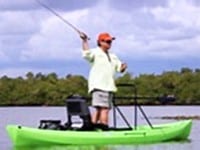 Many kayaks have a standing platform and are stable enough to fish standing up. About the only thing that a kayak can’t match is the range of a powerboat, although paddlecraft operators often paddle 10-20 miles a day in their pursuit of happiness on the water. Paddlecraft never run out of fuel, though the operator might run out of energy. As Dirty Harry always said, you have to know your limits.
Many kayaks have a standing platform and are stable enough to fish standing up. About the only thing that a kayak can’t match is the range of a powerboat, although paddlecraft operators often paddle 10-20 miles a day in their pursuit of happiness on the water. Paddlecraft never run out of fuel, though the operator might run out of energy. As Dirty Harry always said, you have to know your limits.
Packing Your Gear
Most experienced kayak fishermen use some type of crate to hold their fishing gear. You can go cheap with a simple milk crate that you can strap to your kayak, or you can get a fancy waterproof box with attached rod holders as seen below. 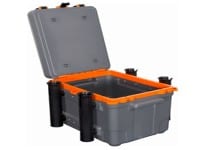 Since capsizing your kayak is always a possibility, the box with a lid on it as below is a pretty good option to keep you from losing your expensive tackle, as long as you secure it to your kayak and keep the lid fastened. One of the most important pieces of gear you can bring with you is a non-folding knife that you wear on your belt or PFD. This knife may become handy if you need to cut your line when you hook onto that 18-foot hammerhead shark or get entangled in your gear if you capsize. Even though you are fishing at water level, a hand net sure comes in handy landing that redfish, speckled trout, or flounder.
Since capsizing your kayak is always a possibility, the box with a lid on it as below is a pretty good option to keep you from losing your expensive tackle, as long as you secure it to your kayak and keep the lid fastened. One of the most important pieces of gear you can bring with you is a non-folding knife that you wear on your belt or PFD. This knife may become handy if you need to cut your line when you hook onto that 18-foot hammerhead shark or get entangled in your gear if you capsize. Even though you are fishing at water level, a hand net sure comes in handy landing that redfish, speckled trout, or flounder.
Using Tethers to Hold Gear
We have all heard about being up a creek without a paddle, and that saying applies in the bay and marshes too. There are many types of paddle tethers that you attach to your paddle and your kayak, and they are only a very minor inconvenience when paddling, but a great convenience when your paddle slips away while you are fighting that saddle blanket flounder. You cannot depend on the built-in paddle holder found on many kayaks to keep your paddle secure, and many paddles do not float. The same thing goes for your rods and reels: use some type of tether to secure them to your kayak. There are several commercial tethers available, but any type of heavy nylon string will do.
Filing a Float Plan
Paddle craft operators should regularly file a float plan before using their vessels, even for short trips. It can be an informal document to tell a person on shore where the operator is planning to go, what time he or she is likely to return, which authorities to call if the boat does not return as scheduled, and how to describe the vessel to first-responders. The best float plan I have ever seen is included in the Coast Guard app that you can download to your cell phone.
Kayak ID Sticker
I still have plenty of kayak ID stickers. We often receive reports of unmanned kayaks floating in the Gulf of Mexico or one of our bays. 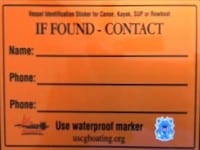 We have two kayaks that we have never found owners for, and very recently we found the bodies of two kayakers who were not wearing life jackets when their kayak capsized. If every kayaker attached some form of identification to their kayak, it will help us locate the owner if one floats off and help us search for missing kayakers. It costs thousands of dollars to launch a search and rescue mission whenever an unmanned vessel is reported. By adding an ID sticker to your kayak, you can save the taxpayers a lot of money if we can resolve the issue with a phone call to the owner.
We have two kayaks that we have never found owners for, and very recently we found the bodies of two kayakers who were not wearing life jackets when their kayak capsized. If every kayaker attached some form of identification to their kayak, it will help us locate the owner if one floats off and help us search for missing kayakers. It costs thousands of dollars to launch a search and rescue mission whenever an unmanned vessel is reported. By adding an ID sticker to your kayak, you can save the taxpayers a lot of money if we can resolve the issue with a phone call to the owner.
Prepare for the Worst
Paddle craft operators should carry whatever equipment will be needed to cope with the worst situation they are apt to encounter on a specific trip, including a life jacket, throw bag, towline, compass, signaling devices, spare paddle (or tether the one paddle), gloves, sun glasses, and a hat with a brim. Don’t forget that knife. If you bring your cell phone, use a bag designed to keep it dry or one of those waterproof covers. There are some nice paddling gloves out there. It is a rough trip in with blisters on your hands. If your kayak is a sit-inside type, add some flotation to the bow and stern. Otherwise it will sink if filled with water. Some flotation systems are solid foam, and others consist of air-filled bags.
Be Visible to Other Boaters
Paddlers should take steps to ensure that boaters in larger vessels will be able to see them relatively easily, even in rough water, high traffic areas, and reduced visibility. That means wearing high visibility clothing and accessories whenever possible. You must have an all-round white light if you are going to operate at night.
Launching Your Kayak
Don’t forget any launch fees if you launch at a private marina such as Stingaree, Blue Water, or the Bolivar Yacht Basin Bait Camp. Many kayakers don’t think the fees apply to them, but they do. There are several public boat ramps where you may launch for free, but let’s give the businesses their fees. Be sure to have all your gear secured and wear your personal flotation device (PFD) at all times. There are many PFDs designed for paddling that give you greater freedom of movement for paddling. Don’t go kayaking alone. I see it all the time, but it is one of the most dangerous things you can do.
Wind, Rain and Weather
Rowdy Yates (Clint Eastwood character on “Rawhide”) isn’t the only one who has to worry about the weather. Paddlers should assess weather, sea state, boat traffic, and other conditions before getting under way and should re-evaluate the situation periodically and at the first sign of any change. They also should remain alert to early hints of fatigue, reserving some of their energy for getting home. You should check the weather forecast before you consider venturing out onto the water. Also check the tide forecasts. You don’t want to fight an outgoing tide to get back to shore. Once you have launched, you can monitor the weather and sea state by operating your marine radio in the scan mode and including the weather channel for the area as well as Channel 16. In our area you should include channels 11, 12 and 13 in order to monitor boat traffic if you are fishing near the Intracoastal Waterway or the Houston Ship Channel. Frequently scan the horizon in all directions in order to detect any bad weather buildup.
Navigating the Marsh
Fishing the marsh is a little bit different in a kayak. In your standard bay fishing boat, you usually ride high enough to see over the top of the grass and can usually find your way back out of the marsh, especially if you have a GPS. In a kayak you cannot see over the top of the marsh grass, so you better have a pretty good method for navigating in the marsh such as either an onboard GPS/sonar or a GPS app on your smart phone. There are many different GPS/sonar combos designed especially for kayaks. The one I use on my kayak has the transducer mounted inside the hull. It works quite well that way, although the water temperature may be off a few degrees. One word about the marsh. Yes, the water is shallow, but don’t for a minute think you can stand up or wade inside the marsh. The bottom is quite silty and will not support a wade fisher. It is quite easy to sink to your waist in the silt, and you certainly cannot walk in it. So, take extra care to not capsize your kayak when you are inside the marsh.
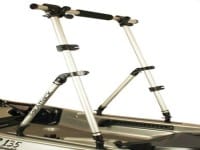 Standing Up to Fish
Standing Up to Fish
Many popular fishing kayaks are wide enough to be stable when you stand up. Standing up in a kayak is somewhat tricky even with a wide kayak. You need something to help pull you up such as a rope tied to the bow of your kayak. There are commercial standing assist bars available, such as below. It helps if your kayak has a built-in accessory rail.
Crossing the Intracoastal Waterway (ICW)
It’s just like your mama taught you: look both ways before crossing and make sure nothing is coming that could hit you as you cross. If you are unsure about crossing due to a close-by barge tow, then don’t try it. 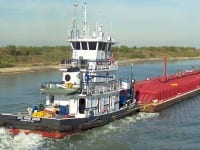
Stay back from the channel as barge tows can put out a considerable wake that can capsize a kayak easily. If you cross a wake, be sure to do so at about a 45-degree angle, the same as you would in a powerboat. Do not anchor in the channel or near the edge. These guys cannot stop for you. Once inside the limits of the Houston-Galveston Vessel Traffic Services, commercial vessels monitor marine channel 13 instead of channel 16, so keep that in mind if you need to contact a vessel in an emergency situation. You will most likely find them on channel 13.
Motorizing Your Kayak
There are several motors designed to attach to a kayak. Some are electric, some are gas powered, and some are propane powered. If you decide to attach one to your kayak, understand that your kayak then becomes a powerboat under both federal and state regulations, and Texas requires the kayak to be registered and display state numbers. This only applies to motors, so if you have a kayak with a propeller or other manual drive system, it is still a kayak under the regulations.
Summary
Recreational boaters have a responsibility to operate safely and within the regulations, and kayakers are no exception to the rules. Do not kayak alone, wear your life jacket, file a float plan, have a reliable means of communication should there be a mishap (a marine VHF/FM walkie talkie is the best recommendation), keep a whistle attached to your life jacket, carry a knife on your person; these and everything else mentioned can help ensure you get home safely after a kayaking trip.
For more information on boating safety, please visit the Official Website of the U.S. Coast Guard’s Boating Safety Division at www.uscgboating.org. Questions about the US Coast Guard Auxiliary or our free Vessel Safety Check program may be directed to me at [email protected]. I am available to perform free Vessel Safety Checks, and I will come to your location to perform them. SAFE BOATING!
[May-11-2020]

 Posted in
Posted in 























